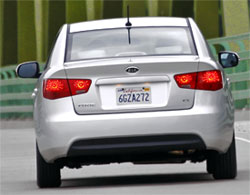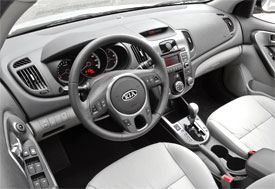2010 Kia Forte
Ever since Hyundai acquired rival Kia, it’s been a full throttle effort to transform the Korean brand’s image from a maker of inexpensive, basic use vehicles, to a high quality, mainstream mark. But their latest effort, the compact Forte, goes head-to-head against industry benchmarks Toyota Corolla and Honda Civic. While the Forte is clearly the most handsome Kia small car ever, it needs more than looks to stay in this race.
The all-new 2010 Forte is a breath of fresh air for the Kia lineup, and simply saying it replaces the generic Spectra would grossly underrate its potential impact.
Available now in a Sedan and Koup, with a “K”, its slightly edgy, American-sourced styling strikes a richer stance than any other Asian mass market small car.
The front-end of our test Forte Sedan, with its flared headlamps, smart-looking grille, and clam shell hood, does have a passing resemblance to the Honda Civic.
But, the well drawn character lines, and up swept side glass, give the Forte Sedan a sharp profile that is its own, and 15, 16, and 17-inch wheels and tires, along with a beefy rear-end, with wrapped and sectioned taillamp housings, cement the image of a well built small sedan.
The front drive Forte finds power from two variable timing I4s. LX and EX trim use a 2.0-liter with 156 horsepower and 144 pound-feet of torque. Our SX sports a 2.4-liter with 173 horsepower and 168 pound-feet of torque. That beats the Toyota Corolla XRS.
 A five-speed manual is standard, with an optional four-speed automatic for LX and EX trim. The SX starts with a 6-speed manual, with a 5-speed automatic on our car.
A five-speed manual is standard, with an optional four-speed automatic for LX and EX trim. The SX starts with a 6-speed manual, with a 5-speed automatic on our car.
Even with more power, Government Fuel Economy ratings for our SX are class competitive at 23 city/31 highway using regular gas. We managed an okay 27.6 miles per gallon in real world driving.
The Forte’s Energy Impact Score is 13.2 barrels of oil consumed per year, with a concise Carbon Footprint of 7.1 annual tons of CO2 emitted.
But, that car will be more sluggish than our SX which still needed 8.9 seconds to accelerate from 0 to 60, finishing the quarter mile in 16.8 seconds at 84 miles per hour. Off the line, the Forte felt energetic, with a good hookup, and steady power build. But the pace was hurt by slow shifts. And, while Kia engines have come a long way, our car’s 2.4 was still buzzier and less refined than top rivals.
Ride and handling show even more improvement. The Forte’s front strut and rear torsion beam suspension adds standard Electronic Stability and Traction control. A high value plus over most rivals.
And it showed. Through the cones our car felt very solid, with no flexy or flimsy feel. Steering is nicely responsive. Front push does come on quickly, so Forte is not as nimble or fun-to-drive as the all-independent Civic. But, it gets through with less body roll.
On more typical pavement, we found the Forte’s ride to be more sophisticated than we expected as well. Not soft, but not stiff either. Here, the Forte is more akin to the Corolla XRS.
The Forte’s Brakes are well above class average. Four-wheel discs with standard ABS and Brake Assist. Hard stops proved short at only 122 feet from 60. Stability was great. The pedal could have more feel but that’s a nit-pick.
The Forte’s cabin matches the exterior. It’s far more inviting than the Spectra, with a Civic and Corolla beating 96.8 cubic feet of passenger space.
 The dash design is a toned-down version of the Kia Soul, with its overlapping gauges and boogey-board shaped center stack.
The dash design is a toned-down version of the Kia Soul, with its overlapping gauges and boogey-board shaped center stack.
Seats are comfortable and well formed with leather an option on our top-level SX, which also included a tilt/telescoping steering wheel.
Forte standard equipment includes six airbags, a CD/MP3/satellite radio, USB port, and Bluetooth. But, air conditioning is an option on the LX.
The rear seats offer decent legroom - even for a six footer - as well as a standard 60/40 split folding feature which extends an already highly useful 14.7 cubic foot trunk.
Pricing for the Kia Forte starts at $14,390 for the LX. That’s over $1700 less than the less well equipped Corolla and Civic. The spread widens with the mid-level Forte EX at $16,490, and top-tier SX at $17,890. And all Fortes come with Kia’s 10 year/100,000 mile powertrain warranty.
Wow. We knew going in the 2010 Forte to be a generational improvement in Kia small cars. But, to be a serious alternative to the Civic and Corolla is packaging, power and economy, ride and handling, and style, is a surprise. But then Kia has been surprising us for years, and the compact Forte is just their latest tour to force.
Specifications
- Engine: Sx 2.4-Liter
- Horsepower: 173
- Torque: 168 Lb Feet
- 0-60 MPH: 8.9 Seconds
- 1/4 Mile: 16.8 Seconds @ 84 MPH
- 60-0 MPH: 122 Feet
- EPA: 23 MPG City/ 31 MPG Highway
- Mixed Loop: 27.6 MPG
- Energy Impact: 13.2 Barrels Oil/Yr
- CO2 Emissions: 7.1 Tons/Yr
2024 Polestar 2
More Range And More Power For The Polestar 2
Volvo is well on their way to making the transition to an all-electric brand, but their sister-brand Polestar is already there. Now, we’ve spent lots of time in their all-wheel drive, five-door Polestar 2, having tested it in 2021, and a year later when a two-wheel drive version arrived. But, EV updates are coming quickly. So, let us be your guide for all that’s new with the Polestar 2.
While we are driving more EVs than ever, we’ve also been spending a lot of time recently circling back to ones we’ve previously tested. As in this new era of electrified vehicles, significant updates are arriving quickly, with R&D investments increasing and retrofitting them easier than ever. This is often done through software updates that can even be accomplished over the air. For 2024, the Polestar 2 has indeed gotten some software updates, but some physical ones as well.
Clearly aimed directly at Tesla’s Model 3 when it arrived; the Polestar 2’s build quality was vastly better, but range definitely came up short. So, addressing that was priority No. 1; and for ’24 the Polestar can travel up to 20% farther than before while consuming 9% less energy, and when it comes time to charge it back up, it can do that 34% faster too.
Range in the Single Motor version increases from a max of 270 to 320 miles thanks to a larger 82-kWh battery pack, and that solitary motor now powers the rear wheels, not the front wheels. It’s also bigger, coming in at 220 kW compared to the previous 170 kW front-wheel drive version, going from 231 to 299 horsepower.
Dual Motors keep the same 78-kWh battery, but still sees a boost from 260 to 276 miles and takes advantage of the larger rear motor for a new combined 310-kW output with 421 horsepower. Our test car has the added Performance Pack, which uses an additional 35 kW to deliver 455 horsepower and 546 lb-ft of torque, though max range drops to just 247 miles.
The new battery in rear-drive 2s will also charge faster, now accepting up to 205 kW for an 80% charge in 20 minutes; max for dual-motors stays at 155 kW, which puts an 80% charge at 34 minutes. Using 32 kWh of electricity per 100 miles, the Dual Motor earns a good efficiency rating.
The [Polestar] 2 has always been one of the most enjoyable EVs to drive, even more so now with that additional power coming from the rear motor.
Unfortunately, extremely cold temperatures kept us from seeing that increased range, as we were only on pace for about 194 miles in our test.
The 2 has always been one of the most enjoyable EVs to drive, even more so now with that additional power coming from the rear motor. And especially when equipped with the Performance Pack as it not only includes more power, but adds 20-inch forged wheels, upgraded brakes, and adjustable Ohlins Dual Flow Valve performance dampers. It greatly improves handling prowess without affecting ride quality, and is easily worth the $5,500 charge if you at all enjoy driving.
Even on a 20-degree track day there was plenty of grip through our handling course. No understeer or oversteer, and lots of feedback through the wheel. There was a nice, strong launch off the line that properly planted us firmly in the seat, and rocketed us to 60 in 4.5 seconds. Power delivery stayed pretty intense up until about 80 mph when there was a definite tapering off. Still, it was a 13.4-second quarter-mile at 102 mph; smooth, quiet, and stable the whole way.
When this car debuted, its Google-based infotainment setup was a novelty, but since then, more and more manufacturers are just “Googling it” so it doesn’t seem out of place at all. The wireless phone charger is easy to access, and there’s a great Harmon/Kardon sound system and panoramic sunroof to enhance the in-cabin experience. Exteriors have also been enhanced with a smooth grille insert and new wheel choices.
Hatchback practicality means 14.3 cu-ft of easy to access cargo space with split-folding seatbacks for longer items and expanding the space to 38.7 cu-ft. Plus, there’s even a sizeable storage bin up front under the hood.
Single Motor Polestar 2 pricing now starts at $51,300, with Dual Motors starting at $56,700; topping out at $64,400.
For a car manufacturer that hasn’t even been around for a decade yet, Polestar has kept itself busy, totally transforming their latest model in just a few years, making the 2024 Polestar 2 even more appealing. They are certainly off to a good start, and with a host of Polestars just over the horizon, including some all-important utility vehicles, this star will be shining even brighter.
Specifications
As Tested
- Motor Setup: Dual Motor
- Horsepower: 455
- 0-60 mph: 4.5 seconds
- EPA Range: 247 miles
- Efficiency : 32 kWh / 100 miles
- Battery Size: 78-kWh
- Torque: 546 lb-ft
- 1/4 Mile: 13.4 seconds at 102 mph
- MW Test Loop: ~ 194 miles
- Peak Charging Rate: 155 kW











































